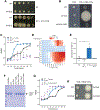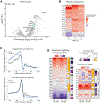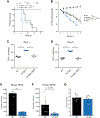The histone chaperone HIR maintains chromatin states to control nitrogen assimilation and fungal virulence
- PMID: 34289370
- PMCID: PMC8493472
- DOI: 10.1016/j.celrep.2021.109406
The histone chaperone HIR maintains chromatin states to control nitrogen assimilation and fungal virulence
Abstract
Adaptation to changing environments and immune evasion is pivotal for fitness of pathogens. Yet, the underlying mechanisms remain largely unknown. Adaptation is governed by dynamic transcriptional re-programming, which is tightly connected to chromatin architecture. Here, we report a pivotal role for the HIR histone chaperone complex in modulating virulence of the human fungal pathogen Candida albicans. Genetic ablation of HIR function alters chromatin accessibility linked to aberrant transcriptional responses to protein as nitrogen source. This accelerates metabolic adaptation and increases the release of extracellular proteases, which enables scavenging of alternative nitrogen sources. Furthermore, HIR controls fungal virulence, as HIR1 deletion leads to differential recognition by immune cells and hypervirulence in a mouse model of systemic infection. This work provides mechanistic insights into chromatin-coupled regulatory mechanisms that fine-tune pathogen gene expression and virulence. Furthermore, the data point toward the requirement of refined screening approaches to exploit chromatin modifications as antifungal strategies.
Keywords: Candida albicans; extracellular proteases; fungal pathogen; histone chaperone; hypervirulence; immune recognition; metabolic genes; nitrogen assimiliation; systemic infections.
Copyright © 2021 The Authors. Published by Elsevier Inc. All rights reserved.
Conflict of interest statement
Declaration of interests The authors declare no competing interests.
Figures







Similar articles
-
The Candida albicans HIR histone chaperone regulates the yeast-to-hyphae transition by controlling the sensitivity to morphogenesis signals.Sci Rep. 2017 Aug 16;7(1):8308. doi: 10.1038/s41598-017-08239-9. Sci Rep. 2017. PMID: 28814742 Free PMC article.
-
The Candida albicans Histone Acetyltransferase Hat1 Regulates Stress Resistance and Virulence via Distinct Chromatin Assembly Pathways.PLoS Pathog. 2015 Oct 16;11(10):e1005218. doi: 10.1371/journal.ppat.1005218. eCollection 2015 Oct. PLoS Pathog. 2015. PMID: 26473952 Free PMC article.
-
The Fungal Histone Acetyl Transferase Gcn5 Controls Virulence of the Human Pathogen Candida albicans through Multiple Pathways.Sci Rep. 2019 Jul 1;9(1):9445. doi: 10.1038/s41598-019-45817-5. Sci Rep. 2019. PMID: 31263212 Free PMC article.
-
Epigenetic Control of Oxidative Stresses by Histone Acetyltransferases in Candida albicans.J Microbiol Biotechnol. 2018 Feb 28;28(2):181-189. doi: 10.4014/jmb.1707.07029. J Microbiol Biotechnol. 2018. PMID: 29169224 Review.
-
From commensal to pathogen: stage- and tissue-specific gene expression of Candida albicans.Curr Opin Microbiol. 2004 Aug;7(4):336-41. doi: 10.1016/j.mib.2004.06.003. Curr Opin Microbiol. 2004. PMID: 15288621 Review.
Cited by
-
Intestinal Flora-Derived Kynurenic Acid Protects Against Intestinal Damage Caused by Candida albicans Infection via Activation of Aryl Hydrocarbon Receptor.Front Microbiol. 2022 Jul 18;13:934786. doi: 10.3389/fmicb.2022.934786. eCollection 2022. Front Microbiol. 2022. PMID: 35923391 Free PMC article.
-
Loss of the accessory chromosome converts a pathogenic tree-root fungus into a mutualistic endophyte.Plant Commun. 2024 Jan 8;5(1):100672. doi: 10.1016/j.xplc.2023.100672. Epub 2023 Aug 9. Plant Commun. 2024. PMID: 37563834 Free PMC article.
-
A J Domain Protein Functions as a Histone Chaperone to Maintain Genome Integrity and the Response to DNA Damage in a Human Fungal Pathogen.mBio. 2021 Dec 21;12(6):e0327321. doi: 10.1128/mbio.03273-21. Epub 2021 Dec 21. mBio. 2021. PMID: 34933457 Free PMC article.
-
Echinocandin Adaptation in Candida albicans Is Accompanied by Altered Chromatin Accessibility at Gene Promoters and by Cell Wall Remodeling.J Fungi (Basel). 2025 Feb 1;11(2):110. doi: 10.3390/jof11020110. J Fungi (Basel). 2025. PMID: 39997404 Free PMC article.
-
Long-read microbial genome assembly, gene prediction and functional annotation: a service of the MIRRI ERIC Italian node.Front Bioinform. 2025 Jun 30;5:1632189. doi: 10.3389/fbinf.2025.1632189. eCollection 2025. Front Bioinform. 2025. PMID: 40662129 Free PMC article.
References
-
- Amin AD, Vishnoi N, and Prochasson P (2013). A global requirement for the HIR complex in the assembly of chromatin. Biochim. Biophys. Acta 1819, 264–276. - PubMed
Publication types
MeSH terms
Substances
Grants and funding
LinkOut - more resources
Full Text Sources
Molecular Biology Databases

